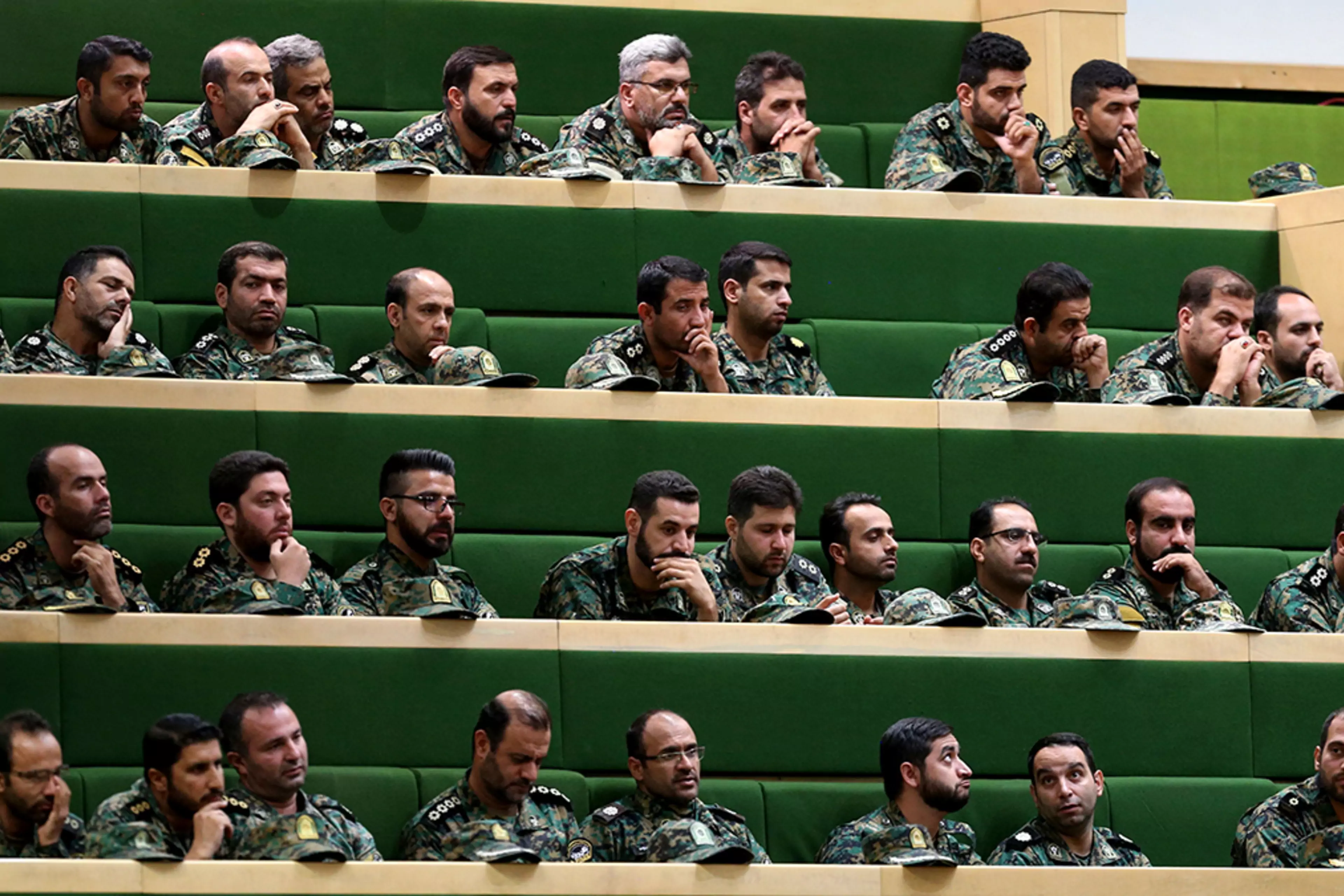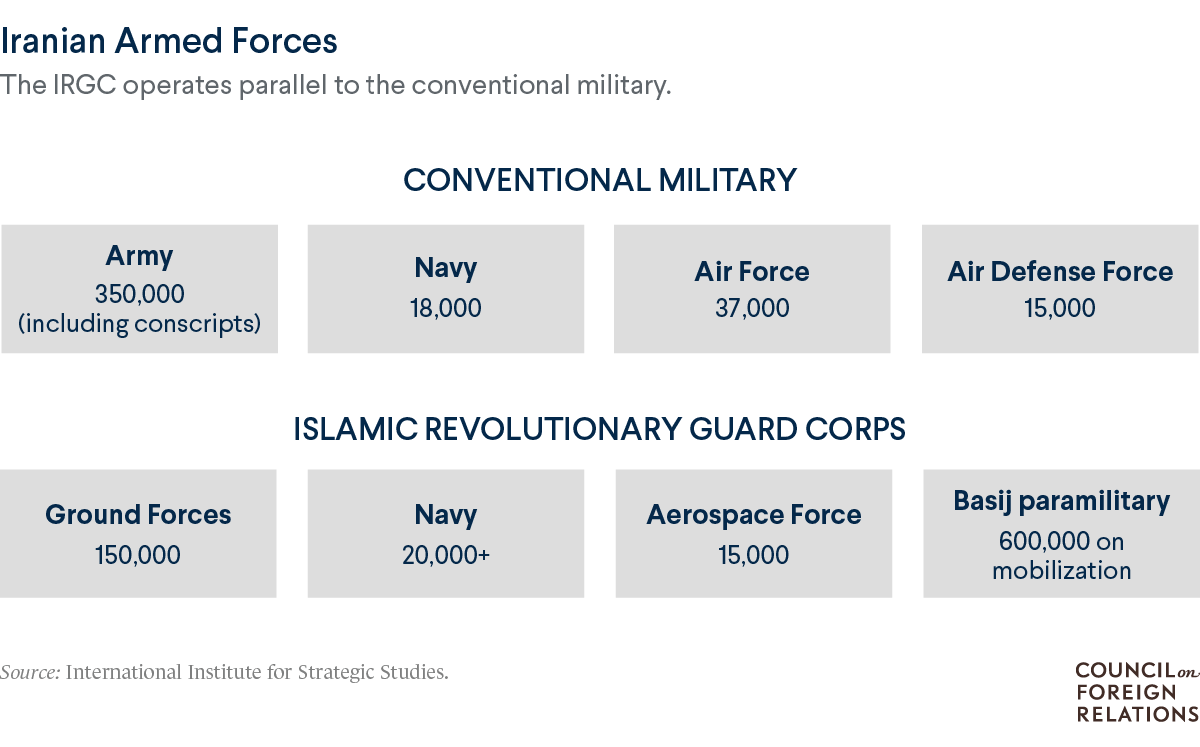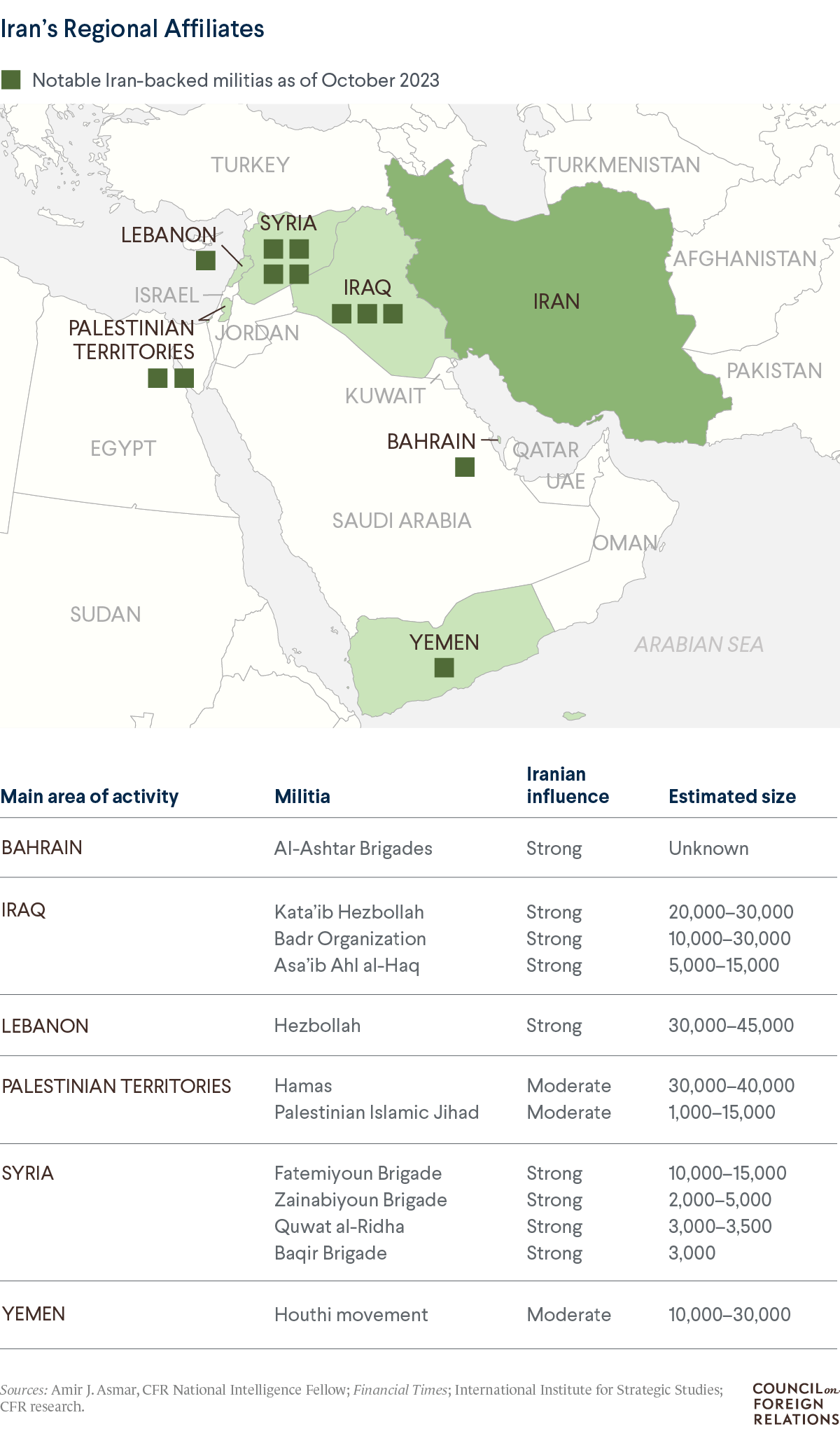Introduction

The Islamic Revolutionary Guard Corps (IRGC) is the ideological custodian of Iran’s 1979 revolution. Charged with defending the Islamic Republic against internal and external threats, the corps has gained an outsize role in executing Iran’s foreign policy and wields control over vast segments of the economy. The IRGC’s ties to armed groups in the region, such as Hezbollah in Lebanon and Hamas in the Palestinian territories, help Iran project influence and power. Answering directly to the supreme leader, the corps is also influential in domestic politics, and many senior officials have passed through its ranks.
The United States designated the IRGC as a terrorist organization in 2019, having already labeled Iran a state sponsor of terrorism, and the European Union (EU) is considering its own terrorist designation for the IRGC. But in recent years, the corps has apparently focused on developments closer to home, as the organization has struggled to suppress months of domestic unrest and now finds itself embroiled, though mostly indirectly, in the latest Israel-Hamas war.
Why was the IRGC established?
The IRGC was founded in the immediate aftermath of Shah Mohammad Reza Pahlavi’s fall, as leftists, nationalists, and Islamists jockeyed to set the course of the revolutionary republic. While the interim prime minister controlled the government and state institutions such as the army, many clerics and disciples of Iran’s founding supreme leader, Ayatollah Ruhollah Khomeini, organized counterweights to those inherited institutions. Among them was the IRGC, which operated beyond the bounds of the law and the judiciary. Answering to the supreme leader, its command structure bypasses the elected president.
The guards were conceived as a “people’s army,” helping consolidate the revolution as Khomeini instituted a state based on the concept of velayat-e faqih, or guardianship of the jurist. The aim was to set up Iran as a constitutional republic, enveloped in a theocratic structure. Khomeini intended for the IRGC to protect the new regime from a coup d’état, such as the one in 1953 that ousted the democratically elected government of Mohammed Mossadeq and restored the shah to power.
How is the IRGC organized?
The Iran-Iraq War (1980–88) transformed the IRGC into more of a conventional fighting force with a command structure similar to that of Western militaries. Now highly institutionalized, it remains a force parallel to that of Iran’s regular armed forces, with upward of 190,000 troops under its command, according to the International Institute for Strategic Studies (IISS). Around half of these personnel are conscripts. The IRGC’s branches include:
- ground forces based across Iran’s 31 provinces and Tehran, which number more than 150,000 troops;
- the Basij paramilitary force, which claims it can mobilize some six hundred thousand volunteers;
- naval forces, separate from the naval branch of Iran’s regular military, which have some twenty thousand sailors and are charged with patrolling Iran’s maritime borders, including the Strait of Hormuz, through which about one-third of the world’s seaborne crude oil passes each year;
- an air force of fifteen thousand personnel, also separate from a parallel branch of the regular military, which runs Iran’s ballistic missile program; and
- a cyber command, which works with IRGC-affiliated businesses on military and commercial espionage, as well as propaganda distribution, according to IISS (its precise relationship with state-affiliated hackers is unclear).

How does the IRGC operate outside of Iran?
As the IRGC first deployed abroad in the Iran-Iraq War, it began sponsoring nonstate armed groups in the region. The expeditionary Quds Force emerged as the IRGC’s de facto external affairs branch, and it has developed ties with armed groups in Afghanistan, Iraq, Lebanon, the Palestinian territories, and elsewhere, providing them with training, weapons, money, and military advice to project Iran’s power abroad. While some of these groups frequently operate independently of Iran and each other, Tehran views them as part of an anti-West “Axis of Resistance” under its sway. Experts say Iran has attempted to strengthen cooperation within this alliance in recent years.
By fostering these groups, Tehran has sought to export its revolution and deter aggression from Western countries and its perennial enemy Israel. The Lebanese movement Hezbollah, for example, shares Iran’s hostility toward the United States and Israel, which occupied southern Lebanon when the group was founded. The 1983 bombings of the U.S. embassy and the U.S. Marine Corps and French paratrooper barracks in Beirut, as well as the assassinations of various regime opponents, have been attributed to Iran and its proxies, namely Hezbollah. Additionally, Western and Middle Eastern intelligence officials have tied the IRGC to the 1994 bombing of a Jewish center in Buenos Aires, Argentina, though Tehran says it wasn’t involved.
The IRGC’s involvement in Iraq after the U.S. invasion in 2003 has become a particular point of contention between Tehran and Washington. In 2007, U.S. President George W. Bush accused the Quds Force of providing Shiite Muslim militants with roadside bombs to kill American forces, though experts inside and outside the U.S. government questioned whether such orders came from Tehran directly. The Donald Trump administration blamed the IRGC for the killings of 608 U.S. troops in Iraq between 2003 and 2011.
Following the 2011 regionwide uprisings commonly known as the Arab Spring, the Quds Force deployed to Syria. Iran initially claimed the operatives were carrying out a limited mission defending Shiite shrines but later acknowledged that the force was helping Syrian President Bashar al-Assad suppress unrest. As the discontent turned to civil war, the Quds Force served not just as military advisors, but also on the front lines, fighting alongside Syrian regime forces, Lebanese Hezbollah militants, and Afghan refugees serving in IRGC proxy militias. Meanwhile, the Arab uprisings similarly sparked a civil war in Yemen, and the IRGC began providing the country’s Houthi rebels with intelligence support, training, and weapons to repel the combined forces of Yemen’s government and Iran’s rival Saudi Arabia.

Iranian officials expanded the Quds Force’s presence in both Iraq and Syria in response to the rise of the Islamic State group. They warned that if the Sunni Muslim militant organization wasn’t defeated there, it would march on Tehran. In Iraq, popular mobilizations of tens of thousands of Shiite militiamen soon eclipsed the national army. Many of these militias pledged loyalty to Iran’s supreme leader and were led by commanders who worked with the Quds Force against the U.S. occupation in the prior decade. The official who led the mobilization, Abu Mahdi al-Muhandis, held both Iraqi and Iranian citizenship and had served as a Quds Force officer. While the mobilization provided the ground forces that rolled back the Islamic State, the United States provided air power, effectively making the guards and U.S. forces tacit partners.
That alliance proved short lived—with the Islamic State largely defeated by 2019, U.S.-Iran hostilities resumed. The following January, a U.S. drone strike killed Muhandis and notorious Quds Force commander Qasem Soleimani, who had cultivated Iran’s many partnerships with armed groups. Washington was keen to stifle the guards’ influence in Iraq, which had come to rely on Iran for security, energy, and trade. Iran and its allies vowed revenge, and Tehran-backed groups ramped up attacks on U.S. coalition forces in Iraq and Syria, with one rocket attack wounding dozens of personnel in 2021.
In October 2023, Hamas fighters and other Palestinian militants perpetrated the most devastating terrorist attack Israel had ever witnessed, immediately raising questions about whether Iran was involved. Various news outlets have indicated that IRGC officials may have directly authorized Hamas’s assault and assisted in planning it, though Hamas and the IRGC have insisted that the Palestinian group acted independently. At minimum, experts say, Tehran was likely aware of an impending attack that it had facilitated through decades of support for the Palestinian fighters. In the ensuing Israel-Hamas conflict, the IRGC has provided arms and other assistance to help its partners in Iraq, Lebanon, Syria, and Yemen to attack Israeli targets in solidarity with Hamas. In December, air strikes widely attributed to Israel killed several IRGC members in Syria, including senior commander Razi Mousavi, who reportedly oversaw transfers of weapons and funds to some of Iran’s armed proxies.
What is the IRGC’s domestic role?
The IRGC has also become a central player in Iran’s domestic politics, evolving into what CFR’s Ray Takeyh has called the most important organization in the country. After gaining power as a counterweight to the 1997–2005 presidency of Mohammad Khatami, a reformist, the number of former IRGC personnel in politics grew further during the first term of Khatami’s successor, Mahmoud Ahmadinejad. Supreme Leader Ali Khamenei—who led the IRGC during the Iran-Iraq War—has appointed former IRGC commanders to top political posts, and former guards in parliament tend to advocate a hard-line foreign policy, as well as support for developing a civilian nuclear program.
Because the IRGC marches in lockstep with the supreme leader’s policy positions, its powers at times seem to outshine that of Iran’s president, who does not control any of the armed forces and has relatively few powers of his own. (Only men have been president, and whether Iranian law requires this is unclear.) While the president has sway over domestic policy—he controls the national budget, for example—his influence over foreign policy is limited. “A president whose policy goals run counter to those of the supreme leader will have little ability to advance his agenda; whereas a president whose goals overlap those of the supreme leader will find broad backing for his initiatives,” says Naval Postgraduate School Professor Afshon Ostovar.
The organization’s influence is still superseded by that of Khamenei, with whom the IRGC shares a mutually beneficial relationship, experts say. Karim Sadjadpour of the Carnegie Endowment for International Peace wrote in a 2009 study [PDF] that Khamenei has developed a relationship with the IRGC that is “increasingly symbiotic, politically expedient for the Leader and economically expedient for the guards,” helping compensate for the fact that he lacks Khomeini’s authority. “He is their commander in chief and appoints their senior commanders, who, in turn, are publicly deferential to him and increasingly reap benefits by playing a more active role in political decision making and economic activity,” wrote Sadjadpour.
In 2007, the Basij was brought under the direct command of the IRGC, a reorganization some analysts attributed to a renewed focus on perceived internal threats to the regime. In June 2009, the IRGC allegedly helped fix the presidential election in Ahmadinejad’s favor. Amid subsequent mass demonstrations alleging fraud, human rights groups documented the Basij attacking protesters. Thousands were detained, and many reformist politicians and activists imprisoned.
The 2013 presidential election was also marred by IRGC intervention. While Hassan Rouhani ultimately prevailed over hard-liners favored by many guards, reports indicated that the IRGC created an atmosphere of intimidation ahead of the vote and pressured the Guardian Council, which vets candidates for their ideological suitability, to cull candidates they deemed unacceptable. Among those disqualified was the prominent revolutionary figure Akbar Hashemi Rafsanjani, who was suspected of being too independent of Khamenei. The corps saw its political support grow with Iran’s 2020 general elections and the 2021 election of Rouhani’s successor, Ebrahim Raisi.
But experts say the IRGC’s heavy hand in politics and its continued willingness to harm Iranians make it unpopular among the public. The organization took a hit to its reputation after it mistakenly shot down a passenger plane flying over Iran’s air space in January 2020, killing all 176 people on board. Most of them were Iranians. In addition, the Basij and broader IRGC have been accused of beating, shooting, sexually assaulting, and torturing Iranians participating in the “Women, Life, Freedom” anti-government protest movement that erupted in Iran in late 2022.
How deeply is the IRGC involved in Iran’s economy?
Among the political interests the guards defend is an economic empire: according to a 2020 report from the Center for Strategic and International Studies, “the IRGC has become the most powerful controller of all important economic sectors across Iran.” The IRGC first became an economic player [PDF] when it was charged with rebuilding infrastructure destroyed in the Iran-Iraq War, and the corps has since expanded into many other industries, including banking, shipping, manufacturing, and consumer imports. Political clout secures IRGC-affiliated companies no-bid contracts from the state to service the oil sector and develop infrastructure.
These economic activities enrich IRGC officials and fund its activities, such as weapons acquisition, covert operations abroad, and Iran’s nuclear program. They also support veterans and the families of killed IRGC members. Public works projects developing Iran’s rural regions build the IRGC goodwill it lacks in urban areas and provide work for Basij volunteers. When floods devastated rural areas in western Iran in April 2019, volunteer guards took a leading role in relief efforts. In Syria, the IRGC has spearheaded Iranian reconstruction projects.
The IRGC also participates in massive black markets. Some analysts say that the spate of U.S. sanctions has benefited the IRGC at the expense of Iran’s public and broader economy; as Iranian businesses have been cut off from licit finance and trade, the IRGC has had greater black-market opportunities. With the U.S. reimposition of oil sanctions lifted under the 2015 Iran nuclear agreement, the IRGC has smuggled oil, mostly to China, and generated millions of dollars for the Quds Force and Hezbollah.
What foreign opposition does the IRGC face?
The United States and its allies are responsible for most of the international condemnation of the IRGC. While Israeli security forces regularly target IRGC-linked groups in Syria, the corps’ other opponents tend to eschew a military approach. The U.S. Treasury Department designated the Quds Force a supporter of terrorism in 2007, and it imposed further sanctions on Quds Force officials in 2011 after a failed assassination attempt on the Saudi ambassador to the United States. Those sanctions were unaffected by the Iran nuclear deal, which Trump withdrew the United States from in 2018.
President Trump designated the IRGC a foreign terrorist organization (FTO) in April 2019, saying it “participates in, finances, and promotes terrorism as a tool of statecraft.” It was the first such designation of a state security agency, but the IRGC had already been heavily sanctioned. U.S. President Joe Biden has kept the IRGC on the terrorist blacklist.
The European Parliament voted in January 2023 to impose its own FTO designation on the IRGC, though EU foreign policy chief Josep Borrell said the bloc’s high court will first need to rule on the matter. In the meantime, the bloc has sanctioned dozens of people and groups tied to the IRGC for abusing anti-government protesters in Iran and supplying drones that Russia has used to wage war on Ukraine.
No comments:
Post a Comment